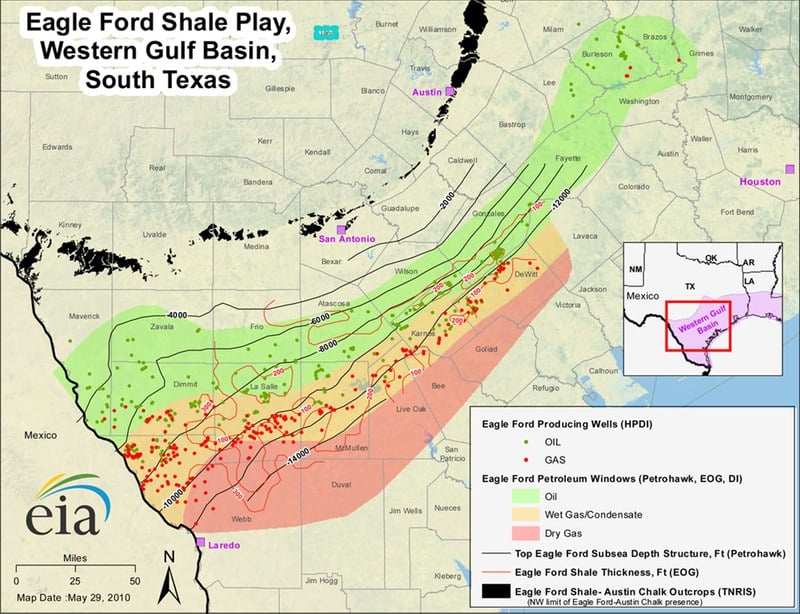
Source: U.S. Energy Information Administration
The field does not stop at the U.S.-Mexico border, but extends south in Mexico’s Burgos Basin and is believed to hold about two-thirds of Mexico’s shale gas resources. As much as 600 trillion cubic feet of recoverable natural gas and 13 billion barrels of recoverable shale oil could lie in Mexico. The country’s national oil company, Pemex, has neither the funds nor the expertise to develop the play and with the opening of the company’s oil industry to foreign companies, it’s just a matter of time (and energy prices) before exploration begins in Mexico’s shale.
The Eagle Ford is the second-most productive field in the United States, yielding more than 1.6 million barrels of oil a day, compared with 1.8 million in the Permian Basin and about 1.2 million in North Dakota’s Bakken field. The U.S. Energy Information Administration (EIA) expects production at the Eagle Ford to top 1.7 million barrels a day by the end of February, with new wells averaging production growth of 566 barrels a day over the 558 barrels a day of growth in January. That projection takes into account a slightly lower rig count.
ALSO READ: 5 Top Independent Oil Producers in the Permian Basin
One of the great benefits of the Eagle Ford play is its location with respect to the refining capacity around Houston and Galveston. Pipeline transportation is tight but not inadequate, as has been the case in the Permian Basin, or nearly non-existent, as in the Bakken play. Another advantage for producers is that Eagle Ford crude is priced against Louisiana Light Sweet (LLS) crude oil, which trades closer to the price for Brent crude than the price for West Texas Intermediate (WTI), primarily because the Gulf Coast is the landing port for most of the crude oil imported into the United States.
The less good news for producers is that the internal rate of return (IRR) at Eagle Ford has dropped from 24% (at a price of $95.57 a barrel) to 14.9% ($74.34) from August through November 2014, according to one study. The November figure is higher than the IRR of 11% for the Bakken, but lower than the 18.2% rate for the Permian Basin.
Here is a look at the Eagle Ford’s top five companies, based on the best production numbers we can find.
EOG Resources
Holding the largest leased acreage position in the Eagle Ford play with 632,000 net acres, EOG Resources Inc. (NYSE: EOG) has a market value is around $47.7 billion. The country’s third-largest natural gas producer is the play’s largest oil producer as well, with about 170,000 barrels a day. Adding in natural gas and natural gas liquid (NGL) production, the company produced about 220,000 barrels of oil equivalent (boe) a day from the Eagle Ford, out of its third quarter total U.S. production of 275,000 boe a day. Based on its 656 drilling permits, the company is also the big dog among Eagle Ford drillers, with more than 100 more permits than the number two permit holder.
EOG’s average realized price on liquids in the third quarter was $100.10, down from $106.16 in the year-ago quarter. Total U.S. production rose from 421,200 boe per day in the third quarter of 2013 to 507,300 boe per day. The company’s composite wellhead crude oil and condensate price for the first nine months of 2014 decreased 6% to $99.87 per barrel compared to $105.76 per barrel for the same period of 2013.
ALSO READ: Lower Oil Prices and the Initial Impact on Houston
BHP Billiton
BHP Billiton PLC (NYSE: BHP) paid more than $12 billion in 2011 to acquire Petrohawk, the company usually credited with opening up the Eagle Ford play. Those were the days when the big mining companies like BHP were printing money. In the same year, BHP paid Chesapeake $4.75 billion for leases on 487,000 acres in the Haynesville shale play, and the mining giant’s $39 billion effort to acquire Potash Corp. of Saskatchewan was withdrawn before it could be rejected by the Canadian government. The Australia-based mining giant has market cap of nearly $120 billion.
For its fiscal year ended in June 2014, BHP reported revenues of $4.26 billion from onshore U.S. production. Consolidated revenue for the company in the fiscal year totaled $67.21 billion. BHP generates a little more than 6% of its worldwide revenues from all its U.S. hydrocarbon assets, which partially explains the lack of detail in the company’s Form 20-F.
BHP had 313 drilling permits in the Eagle Ford play at last count, and the company is expected to produce about 75,000 barrels of oil per day in 2014. Adding in its natural gas and NGL production BHP’s total production in the Eagle Ford is expected to run around 162,000 boe per day in 2014.
ConocoPhillips
This is the largest pure-play exploration and production company in the United States and the third-largest oil producer in the Eagle Ford. The market cap of ConocoPhillips (NYSE: COP) is about $75.9 billion. In the third quarter of 2014, Conoco’s average daily net production of crude in the lower 48 states totaled 191,000 barrels a day and the average realized price per barrel was $87.91, compared with a price of $100.25 in the third quarter of 2013.
Conoco does not offer more detailed data on production by field, but does note that the Eagle Ford and Bakken plays combined delivered 212,000 boe per day. Conoco is not among the top five permit holders in the Eagle Ford play, but the company’s leases of more than 200,000 net acres positions it at eighth-largest there.
ALSO READ: The Bullish and Bearish Outlook for Chevron in 2015
Chesapeake Energy
Chesapeake Energy Corp. (NYSE: CHK) holds the second-largest number of drilling permits in the Eagle Ford play with 546 and the second-largest net acreage position with nearly 450,000 net acres. The company has been shedding assets for years now but still maintains about 13 million net acres of U.S. onshore leases, and it has a market cap of about $11.9 billion. The company is expected to produce about 80,000 barrels a day from the Eagle Ford in 2014.
In the third quarter, Chesapeake reported oil production totaling 9.1 million barrels, or about 101,000 barrels per day for its Southern Division, which includes the Eagle Ford among several unconventional oil and gas plays. The average sales price totaled $94.14 per barrel, compared with production of 9.8 million barrels in the third quarter of 2013, with an average sales price of $101.57 a barrel.
Marathon Oil
Just trailing Chesapeake in expected production from the Eagle Ford play in 2014 with about 75,000 barrels a day of liquids is Marathon Oil Corp. (NYSE: MRO). The company also claims the fourth-highest total of drilling permits in the Eagle Ford and the ninth-largest net acreage position, with about 200,000 net acres. Marathon’s market cap is around $17.3 billion.
Marathon beat Conoco to the punch by spinning off its refining operations and becoming a pure-play exploration and production company in 2011. The company reported that net sales volumes from the Eagle Ford in the third quarter of 2014 totaled 75,000 barrels a day, up by nearly 50% over the 52,000 barrels a day produced in the third quarter of 2013. The average realized price per barrel in the third quarter was $93.51, down from $104.08 in the prior-year quarter.
ALSO READ: Commerce Department Essentially OKs Crude Oil Exports
Sponsored: Attention Savvy Investors: Speak to 3 Financial Experts – FREE
Ever wanted an extra set of eyes on an investment you’re considering? Now you can speak with up to 3 financial experts in your area for FREE. By simply
clicking here you can begin to match with financial professionals who can help guide you through the financial decisions you’re making. And the best part? The first conversation with them is free.
Click here to match with up to 3 financial pros who would be excited to help you make financial decisions.
Thank you for reading! Have some feedback for us?
Contact the 24/7 Wall St. editorial team.



